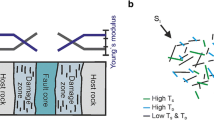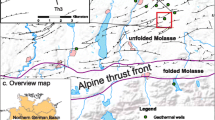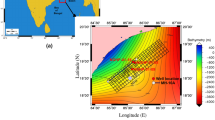Abstract
The studied oilfield in the Zagros folded belt accommodates hydrocarbons in the Cretaceous carbonate rocks of the Ilam and Sarvak Formations. The compressional tectonic regime of the study area is reflected in the presence of the NW-SE trending active Ch.1 and Ch.2 thrust fault-related anticlines and associated NW-SE trending reverse faults. The NW-SE trending reverse faults have formed a pop-up structure in the crest of the Ch.2 anticline dividing it into 3 sectors (A, B, and C) with different geomechanical characteristics. Sector B as the high-strain central part of the pop-up structure despite Sectors A and B as the low-strain parts (in the footwall of the reverse faults forming the pop-up structure), is considered a high-risk region for performing acid fracturing stimulation of the reservoirs. In seismic time slices at the Gachsaran level, ChF.1 and ChF.2 faults with NE-SW trend display sinistral and dextral displacement respectively, representing tear faults related to the basal thrust of the Zagros Fore-dip Fault. Horizontal and vertical stress magnitudes for the study area were derived from well-log data. The horizontal stress orientations were established from the dominant directions of the induced fractures and breakouts observed from the FMI log data and are in ~ 030° (NE-SW) and ~ 120° (NW-SE), respectively. Based on these determined horizontal stress orientations, the expected induced fracture propagation direction is ~ 030° and their opening would likely occur in the direction ~ 120°. Based on this deduced stress information, the optimal azimuthal perforation would be from 000° to 060° for acid-fracture stimulation of Ilam and Sarvak reservoirs.










Similar content being viewed by others
Data availability
The authors do not have permission to disclose the data and materials from the studied wellbores.
Abbreviations
- ChF.1:
-
Changuleh Fault.1
- ChF.2:
-
Changuleh Fault.2
- DTCO:
-
Compressional sonic well log
- DTp:
-
P-wave sonic log
- DTs:
-
S-wave sonic log
- E :
-
Young’s modulus
- FMI:
-
Fullbore Formation Micro-Imager
- GPS:
-
Global positioning system
- HZF:
-
High Zagros Fault
- 1D MEM:
-
One-dimensional Mechanical Earth Model
- LOT:
-
Leak-off test
- MDT:
-
Modular formation dynamics tester
- MFF:
-
Mountain Front Fault
- MZT:
-
Main Zagros Thrust
- OBG:
-
Overburden gradient
- Pp :
-
Pore pressure
- Png :
-
hydrostatic gradient
- Sv :
-
Vertical stress
- SHmax :
-
maximum horizontal stress
- Shmin :
-
Minimum horizontal principal stress
- Δtml :
-
Travel time derived from mud line
- Vs :
-
S wave velocity
- Vp :
-
P wave velocity
- XLOT:
-
Extended leak off test
- Z:
-
Depth
- ZFF :
-
Zagros Fore-dip Fault
- α:
-
Biot’s constant
- c:
-
Constant (0.0013)
- Δt:
-
Travel time derived from the compressional sonic well log
- Δt:
-
m travel time derived from shale
- \({{\upepsilon }}_{y}\) :
-
Linear strain elongation components in “Y” axis direction
- \({{\upepsilon }}_{x}\) :
-
Linear strain elongation components in “X” axis direction
- g :
-
Acceleration due to gravity
- ρ b :
-
Bulk density of the rocks
- ρ sea :
-
Sea water density
- ν :
-
Poisson’s ratio
- z :
-
Depth
References
Aadnoy BS, Bell JS (1998) Classification of drilling-induced fractures and their relationship to in-situ stress directions. The Log Analyst 39(06)
Agard P, Omrani J, Jolivet L, Mouthereau F (2005) Convergence history across Zagros (Iran): constraints from collisional and earlier deformation. Int J Earth Sci 94:401–419. https://doi.org/10.1007/s00531-005-0481-4
Alavi M (1994) Tectonics of the zagros orogenic belt of iran: new data and interpretations
Allen MB, Armstrong HA (2008) Arabia–Eurasia collision and the forcing of mid- cenozoic global cooling. Palaeogeogr Palaeoclimatol Palaeoecol 265:52–58. https://doi.org/10.1016/j.palaeo.2008.04.021
Azizi H, Federico L (2018) J. Robert Stern, Sh. Hasannejad, and Y. Asahara
Ballato P, Uba CE, Landgraf A, Strecker MR, Sudo M, Stockli DF, Friedrich A, and S. H.Tabatabaei (2011) Arabia-Eurasia continental collision: insights from late tertiary foreland-basin evolution in the Alborz Mountains, northern Iran. Bulletin 123:106–131. https://doi.org/10.1130/B30091.1
Bell J, Gough D (1979) Northeast-Southwest compressive stress in Alberta evidence from oil wells. Earth Planet Sci Lett 45:475–482 : 10.1016/0012- 821X(79)90146-8
Berberian M (1995) Master blind thrust faults hidden under the Zagros folds: active basement tectonics and surface morphotectonics. Tectonophysics 241:193–224. https://doi.org/10.1016/0040-1951(94)00185-C
Berberian M, King GCP (1981) Towards a paleogeography and tectonic evolution of Iran. Can J Earth Sci 18(2):210–265. https://doi.org/10.1139/e81-019
Beydoun ZR, Hughes Clarke MW, Stoneley R (1992) Petroleum in the Zagros Basin: a late tertiary Foreland Basin Overprinted onto the outer edge of a vast hydrocarbon-rich paleozoic-mesozoic Passive-Margin Shelf, Foreland Basins and fold belts. Roger W. Macqueen, Dale A. Leckie
Binh NTT, Tokunaga T, Goulty NR, Son HP, Van Binh M (2011) Stress state in the Cuu Long and nam con Son basins, offshore Vietnam. Mar Pet Geol 28(5):973–979. https://doi.org/10.1016/j.marpetgeo.2011.01.007
Blanton T, Olson JE (1999) Stress magnitudes from logs: effects of tectonic strains and temperature. SPE Reservoir Eval Eng 2(01):62–68. https://doi.org/10.2118/54653-PA
Chatterjee S, Mukherjee S (2023) Review on drilling-induced fractures in drill cores
Comprehensive analysis of stress magnitude and orientations and natural fractures in complex structural regimes oil reservoir: Implications for tectonic and oil field development in the Zagros suture zone, Marine and Petroleum Geology 160: 106615. https://doi.org/10.1016/j.marpetgeo.2023.106615
Darin MH, Umhoefer PJ (2022) Diachronous initiation of Arabia–Eurasia collision from eastern Anatolia to the southeastern Zagros Mountains since middle Eocene time. Int Geol Rev 64(18):2653–2681. https://doi.org/10.1080/00206814.2022.2048272
Eaton BA (1975) The equation for geopressure prediction from well logs. Paper presented at the Fall Meeting of the Society of Petroleum Engineers of AIME, Dallas, Texas, September 28. SPE 5544. https://doi.org/10.2118/5544-MS
Emami H, jverges Vergés J, Nalpas T, Gillespie P, Sharp I, Karpuz R, Blanc EP, Goodarzi MGH (2010) Structure of the Mountain Front Flexure along the Anaran anticline in the Pusht-e Kuh Arc (NW Zagros, Iran): insights from sand box models. Geol Soc Lond Special Publications 330:155–178. https://doi.org/10.1144/SP330.9
Fakhari MD, Axen GJ, Horton BK, Hassanzadeh J, Amini A (2008) Revised age of proximal deposits in the Zagros foreland basin and implications for cenozoic evolution of the high Zagros. Tectonophysics 451:170–185
Falcon NL (1974) Southern Iran: Zagros Mountains. In: Spencer A (ed) Mesozoic- cenozoic orogenic belts, data for orogenic studies: Alpine-Himalayan orogens, Geological Society, 4th edn. Special, London, pp 199–211
Ghanadian M, Faghih A, Abdollahie Fard I, Kusky T, Maleki M (2017)
Ghassemi MR, Nayeb S (2015) Active surface cracking in Aghajari formation of the Azar oil field, Zagros, western Iran. Mar Pet Geol 68:498–508. https://doi.org/10.1016/j.tecto.2007.11.064
Gowida A, Ibrahim AF, Elkatatny S, Ali A (2022) ACS Omega 7(16):13507–13519. https://doi.org/10.1021/acsomega.1c06596PMID: 35559186; PMCID: PMC9088765 New Empirical Correlations to Estimate the Least Principal Stresses Using Conventional Logging Data
Heidbach O, Rajabi M, Reiter K, Ziegler MO, and the WSM Team (2016). World Stress Map Database Release 2016. GFZ Data Services. https://doi.org/10.5880/WSM.2016.001
Heidbach O, Rajabi M, Cui X, Fuchs K, Müller B, Reinecker J, Reiter K, Tingay M, Wenzel F, **e F, Ziegler MO, Zoback M-L, Zoback MD (2018) Crustal stress pattern across scales. Tectonophysics 744:484–498. https://doi.org/10.1016/j.tecto.2018.07.007. The World Stress Map database release 2016
Homke S, Vergés J, Garcés M, Emami H, Karpuz R (2004) Magnetostratigraphy of Miocene–Pliocene Zagros Foreland deposits in the front of the Push-e kush arc (Lurestan Province, Iran). Earth Planet Sci Lett 225:397–410. https://doi.org/10.1016/j.epsl.2004.07.002
Horton B, Hassanzadeh J, Stockli D, Axen G, Gillis R, Guest B, Amini A, Fakhari M, Zamanzadeh S, Grove M (2008) Detrital zircon provenance of neoproterozoic to cenozoic deposits in Iran: implications for chronostratigraphy and collisional tectonics. Tectonophysics 451:97–122. https://doi.org/10.1016/j.tecto.2007.11.063
Jolivet L, Faccenna C (2000) Mediterranean extension and the Africa-Eurasia collision. Tectonics 19:1095–1106. https://doi.org/10.1029/2000TC900018
Kirsch C (1898) Die theorie Der Elastizitat Und die bedurfnisse Der festigkeitslehre. Z des VereinesDeutscherIngenieure 42:797–807
MacLeod JH, Roohi M (1972) Geological map of Mehran, Scale 1:100,000. National Iranian Oil Company
Mafakheri Bashmagh N, Lin W, Radwan AE (2024) and A. Khaksar Manshad
Mahmoudi Sh, Fernando C, Masoudi F, Mehrabi B, Mohajjel M (2011). Marine and Petroleum Geol 151:106089. https://doi.org/10.1016/j.marpetgeo.2022.106089
McGarr A, Gay N (1978) State of stress in the Earth’s crust. Annu Rev Earth Planet Sci 6:405–436. https://doi.org/10.1146/annurev.ea.06.050178.002201
McQuarrie N, Stock J, Verdel C, Wernicke B (2003) Cenozoic evolution of neotethys and implications for the causes of plate motions. Geophys Res Lett 30:2036. https://doi.org/10.1029/2003GL017992
Mohajjel M, Fergusson CL, Sahandi MR (2003) Cretaceous–tertiary convergence and continental collision, Sanandaj–Sirjan Zone, western Iran. J Asian Earth Sci 21(4):397–412. https://doi.org/10.1016/S1367-9120(02)00035-4
Molaghab A, Taherynia MH, FatemiAghda SM, Fahimifar A (2017) Determination of minimum and maximum stress profiles using wellbore failure evidences: a case study-a deep oil well in the southwest of Iran. J Petroleum Explor Prod Technol 7:707–715. https://doi.org/10.1007/s13202-017-0323-5
Nian T, Wang G, **ao C, Zhou L, Sun Y, Song H (2016) Determination of in-situ stress orientation and subsurface fracture analysis from image-core integration: an example from ultra-deep tight sandstone (BSJQK formation) in the Kelasu Belt, Tarim Basin. J Petrol Sci Eng 147:495–503. https://doi.org/10.1016/j.petrol.2016.09.020
Nouri F, Azizi H, Stern RJ, Asahara Y (2023) The Sanandaj-Sirjan Zone (W. Iran) was a jurassic passive continental margin: evidence from igneous rocks of the Songhor area. Lithos 440–44:107023. https://doi.org/10.1016/j.lithos.2023.107023
Plumb RA, Hickman SH (1985) Stress-induced borehole elongation: a comparison between the four-arm dip meter and the borehole televiewer in the auburn geothermal well. J Geophys Research: Solid Earth 90:5513–5521. https://doi.org/10.1029/JB090iB07p05513
Rajabi M, Sherkati S, Bohloli B, Tingay M (2010) Subsurface fracture analysis and determination of in-situ stress direction using FMI logs: an example from the Santonian carbonates (Ilam Formation) in the Abadan Plain, Iran. Tectonophysics 492:192–200. https://doi.org/10.1016/j.tecto.2010.06.014
Sarkarinejad K, Pash RR, Motamedi H, Yazdani M (2018) Deformation and kinematic evolution of the subsurface structures: Zagros Foreland fold-and-thrust belt, northern Dezful Embayment, Iran. Int J Earth Sci (Geol Rundsch) 107:1287–1304. https://doi.org/10.1007/s00531-017-1532-3
Schmitt DR, Currie CA, Zhang L (2012) Crustal stress determination from boreholes and rock cores: fundamental principles. Tectonophysics 580:1–26. https://doi.org/10.1016/j.tecto.2012.08.029
Sepehr M, Cosgrove J (2004) Structural framework of the Zagros Fold–thrust belt, Iran. Mar Pet Geol 21:829–843. https://doi.org/10.1016/j.marpetgeo.2003.07.006
Stocklin J (1968) Structural history and tectonics of Iran: a review. Am Association Petroleum Geol Bull 52:1229–1258
Tang Z, Kong X, Duan W, Gao J (2021) Wellbore breakout analysis and the maximum horizontal stress determination using the thermo-poroelasticity model. J Petrol Sci Eng 196:107674. https://doi.org/10.1016/j.petrol.2020.107674
Tavakoli-Shirazi S, Frizon de Lamotte D, Wrobel-Daveau JC, Ringenbach JC (2013a) PrePermian uplift and diffuse extensional deformation in the high Zagros Belt (Iran): integration in the geodynamic evolution of the arabian plate. Arab J Geoscience 6:2329–2342
The Late Jurassic Panjeh submarine volcano in the northern Sanandaj-Sirjan Zone, northwest Iran: Mantle plume or active margin? Lithos. 308–309:364–380, https://doi.org/10.1016/j.lithos.2018.03.019
Tingay M, Reinecker J, Müller B (2008) Borehole breakout and drilling-induced fracture analysis from image logs. World Stress Map Project. 1–8
Twiss R, Moores E (1992) Structural geology. W.H. Freeman and Company, New York
Zang A, Stephansson O, Heidbach O, Janouschkowetz S (2012) World stress map database as a resource for rock mechanics and rock engineering. Geotech Geol Eng 30:625–646. https://doi.org/10.1007/s10706-012-9505-6
Zarifi Z, Nilfouroushan F, Raeesi M (2014) Crustal stress map of Iran: insight from seismic and geodetic computations. Pure appl Geophys 171:1219–1236. https://doi.org/10.1007/s00024-013-0711-9
Zhang J, Fan Y, Liu W, Liu H, Xu B (2023) In situ stress evolution and Fault-Slip Tendency Assessment of an Underground Gas Storage Reservoir in the Turpan Basin (China): in situ stress measurements and coupled simulations. Rock Mech Rock Eng 56:8019–8039. https://doi.org/10.1007/s00603-023-03477-y
Zoback MD (2007) Reservoir geomechanics. Cambridge University Press, Cambridge
Zoback M, Barton C, Brudy M, Castillo D, Finkbeiner T, Grollimund B, Moos D, Peska P, Ward C, Wiprut D (2003) Determination of stress orientation and magnitude in deep wells. Int J Rock Mech Minings Sci 40:1049–1076
Acknowledgements
The authors sincerely acknowledge the University of Tabriz for their support in conducting this research.
Funding
No funding was received to conduct this study.
Author information
Authors and Affiliations
Contributions
Fatemeh Mesbahi: Methodology, Software, Writing- Original draft preparation. Ali Kadkhodaie: Methodology, Reviewing David Wood: Methodology, Reviewing.
Corresponding author
Ethics declarations
Consent for publication
All authors have consented to the publication of this manuscript and agree with its content.
Competing interests
The authors declare no competing interests.
Additional information
Publisher’s Note
Springer Nature remains neutral with regard to jurisdictional claims in published maps and institutional affiliations.
Rights and permissions
Springer Nature or its licensor (e.g. a society or other partner) holds exclusive rights to this article under a publishing agreement with the author(s) or other rightsholder(s); author self-archiving of the accepted manuscript version of this article is solely governed by the terms of such publishing agreement and applicable law.
About this article
Cite this article
Mesbahi, F., Kadkhodaie, A. & Wood, D.A. In-situ stress regime analysis and mechanical earth modeling of the southwestern sector of the Zagros folded belt, SW Iran: applications for acid fracturing in Ilam and Sarvak carbonate formations. Carbonates Evaporites 39, 70 (2024). https://doi.org/10.1007/s13146-024-00987-w
Accepted:
Published:
DOI: https://doi.org/10.1007/s13146-024-00987-w




